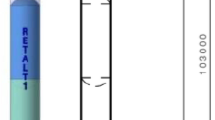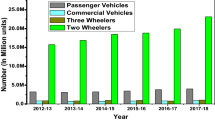Abstract
Small- and medium-sized compact hybrid remotely operated vehicles (HROVs) are particularly sensitive to force control, and research on the interaction of their propulsion system is key and essential to their development. In this paper, the effects of the relative position to the cabin, ambient velocity and rotational speed of adjacent thrusters on the thrust characteristics of a propulsion system are analyzed. The influence of the propulsion system at high flow velocity is obviously different from that in static water. At high flow velocity, different rotational speeds of adjacent thrusters can result in thrust variation of more than 18% for the observed thrusters, compared to no rotation of adjacent thrusters. In Group 1 (with larger space), the operating thrusters arranged perpendicular to the flow and along the flow can affect the thrust change by 19.87% and 19.27%, respectively. In Group 2 (with smaller space), those are 12.71% and 17.28%, respectively. An explanation is given for the mechanism of the influence of adjacent thrusters at different positions.
























Similar content being viewed by others
Abbreviations
- HROV:
-
Hybrid remotely operated vehicle
- AUV:
-
Autonomous underwater vehicle
- ROV:
-
Remote operated vehicle
- HUV:
-
Hybrid underwater vehicle
- DP:
-
Dynamic positioning
- CIA:
-
Critical incoming angle
- CFD:
-
Computational fluid dynamics
- DOFs:
-
Degrees of freedom
- KRISO:
-
Korea Research Institute of Ships and Ocean Engineering
- MOERI:
-
Maritime Ocean Engineering Research Institute
- SST:
-
Shear stress transport turbulence model
- MRF:
-
Multi-reference frame
- GCI:
-
Grid convergence index
- β :
-
Thruster placement angle (deg)
- D 0 :
-
Diameter of the KP458 propeller (m)
- D:
-
Diameter of thruster (m)
- τ ij :
-
Shear stress (Pa)
- ρ :
-
Density of fluid (kg/m3)
- p :
-
Pressure (Pa)
- \({\mathbf{\bar{v}}}\) :
-
Mean velocity vector (m/s)
- \({{\bar{p}}}\) :
-
Mean pressure (Pa)
- I :
-
Identity tensor
- \({\mathbf{\bar{T}}}\) :
-
Mean viscous stress tensor
- \({\mathbf{{f}}}_b\) :
-
Resultant of the body forces
- \({\mathbf{{T}}}_{RANS}\) :
-
Reynolds stress tensor
- μ t :
-
Turbulent eddy viscosity
- r ji :
-
Grid refinement factor
- K T :
-
Thrust coefficient
- p a :
-
Apparent order
- h i :
-
Representative grid size of the ith grid
- ϕ i :
-
Key variable on the grid
- ϕ ext 43 :
-
Extrapolated value
- e a 43 :
-
Approximate relative error
- e ext 43 :
-
Extrapolated relative error
- GCIfine 43 :
-
Fine-grid convergence index
- K Ti :
-
Thrust coefficient of thruster i
- K Te :
-
Experimental thrust coefficient
- \(K_{TS}\) :
-
Thrust coefficient calculated by steady-state calculation
- \(K_{TU}\) :
-
Thrust coefficient calculated by unsteady-state calculation
- \(K_{Qe}\) :
-
Experimental torque coefficient
- \(K_{QS}\) :
-
Torque coefficient calculated by steady-state calculation
- \(K_{QU}\) :
-
Torque coefficient calculated by unsteady-state calculation
- \(\eta_{e}\) :
-
Experimental efficiency of the KP458 propeller
- \(\eta_{S}\) :
-
Efficiency calculated by steady-state calculation
- \(\eta_{U}\) :
-
Efficiency calculated by unsteady-state calculation
- V max :
-
Maximum velocity of the fluid flow caused by thruster (m/s)
- ω :
-
Rotational speed of thruster (r/s)
- θ f :
-
Influence angle upstream of thruster (deg)
- θ b :
-
Influence angle downstream of thruster (deg)
- V :
-
Velocity magnitude (m/s)
- \(\bar{V}\) :
-
Ambient flow velocity magnitude(m/s)
- d :
-
Distance between propeller central axis and cabin edge (m)
- α :
-
Flow velocity angle (deg)
- γ :
-
Flow direction angle(deg)
- Ti :
-
Thrust of thruster i(N)
- T 0 :
-
Thrust of upstream thruster in still water(N)
- T :
-
Thrust of downstream thruster in still water(N)
- x 0 :
-
Distance between the thrusters in still water(m)
- φ :
-
Angle of thruster deflection(deg)
- t φ :
-
Ratio of the downstream thruster with deflection angle to the upstream propeller
References
Bao-Ji Z, Xin-Di L, Wen-Xuan S (2020) Resistance performance simulation of remotely operated vehicle in deep sea considering propeller rotation. Proc Inst Mech Eng M J Eng Maritime Environ 234(2):585–598. https://doi.org/10.1177/1475090219867604
Celik IB, Ghia U, Roache PJ, Freitas CJ, Coleman H, Raad PE (2008) Procedure for estimation and reporting of uncertainty due to discretization in CFD applications. J Fluids Eng Trans ASME 130(7):0780011–0780014. https://doi.org/10.1115/1.2960953
Dang J, Laheij H (2004) Hydrodynamic aspects of steerable thrusters. In: Dynamic positioning conference, p 33
Dong Y, Duan X, Feng S, Shao Z (2012) Numerical simulation of the overall flow field for underwater vehicle with pump jet thruster. Procedia Eng 31:769–774. https://doi.org/10.1016/j.proeng.2012.01.1100
Du H, Yan T, Liu S, He B, Zhao D (2023) Mathematical modeling and dynamic analysis of a spherical contact vector thruster. Iran J Sci Technol Trans Mech Eng. https://doi.org/10.1007/s40997-022-00560-7
Du X, Cui H, Zhang Z (2018) Dynamics model and maneuverability of a novel AUV with a deflectable duct propeller. Ocean Eng 163:191–206. https://doi.org/10.1016/j.oceaneng.2018.05.041
Felli M, Camussi R, Di Felice F (2011) Mechanisms of evolution of the propeller wake in the transition and far fields. J Fluid Mech 682:5–53. https://doi.org/10.1017/jfm.2011.150
Felli M, Falchi M (2018) Propeller wake evolution mechanisms in oblique flow conditions. J Fluid Mech 845:520–559. https://doi.org/10.1017/jfm.2018.232
Ferreira CZ, Cardoso R, Meza MEM, Ávila JPJ (2018) Controlling tracking trajectory of a robotic vehicle for inspection of underwater structures. Ocean Eng 149:373–382. https://doi.org/10.1016/j.oceaneng.2017.12.032
Gao FD, Pan CY, Han YY (2012) Numerical computation and analysis of unsteady viscous flow around autonomous underwater vehicle with propellers based on sliding mesh. J Central South Univ Technol (engl Edn) 19(4):944–952. https://doi.org/10.1007/s11771-012-1096-0
Gorji M, Ghassemi H, Mohamadi J (2019) Effect of rake and skew on the hydrodynamic characteristics and noise level of the marine propeller. Iran J Sci Technol Trans Mech Eng 43(1):75–85. https://doi.org/10.1007/s40997-017-0108-y
Javanmard E, Yari E, Mehr JA, Mansoorzadeh S (2019) Hydrodynamic characteristic curves and behavior of flow around a surface-piercing propeller using computational fluid dynamics based on FVM. Ocean Eng 192(November 2018):106445. https://doi.org/10.1016/j.oceaneng.2019.106445
Ji B, Luo X, Peng X, Wu Y, Xu H (2012) Numerical analysis of cavitation evolution and excited pressure fluctuation around a propeller in non-uniform wake. Int J Multiph Flow 43:13–21. https://doi.org/10.1016/j.ijmultiphaseflow.2012.02.006
Joung T-H, Sammut K, He F, Lee S-K (2012) Shape optimization of an autonomous underwater vehicle with a ducted propeller using computational fluid dynamics analysis. Int J Naval Architect Ocean Eng 4(1):44–56. https://doi.org/10.3744/jnaoe.2012.4.1.044
Jung D, Gamard S, George WK (2004) Downstream evolution of the most energetic modes in a turbulent axisymmetric jet at high reynolds number. Part 1. The near-field region. J Fluid Mech 514:173–204. https://doi.org/10.1017/S0022112004000163
Kim J, Chung WK (2006) Accurate and practical thruster modeling for underwater vehicles. Ocean Eng 33(5–6):566–586. https://doi.org/10.1016/j.oceaneng.2005.07.008
Kumar P, Mahesh K (2017) Large eddy simulation of propeller wakeâ instabilities. J Fluid Mech 814:361–396. https://doi.org/10.1017/jfm.2017.20
Liu Y, Gong Q (2020) Numerical investigation on the flow characteristics and hydrodynamic performance of tandem propeller. Appl Ocean Res 101(July):102292. https://doi.org/10.1016/j.apor.2020.102292
Majumder P, Avanapu DK, Maity S (2022) Numerical investigation of significance of duct angle of attack and duct position in a ducted propeller in the presence of propeller boss cap fin. Iran J Sci Technol Trans Mech Eng 46(3):745–760. https://doi.org/10.1007/s40997-021-00457-x
Palmer AR, Hearn GE, Stevenson P (2009) Thruster interactions on autonomous underwater vehicles. In: Proceedings of the international conference on offshore mechanics and arctic engineering—OMAE 4(PART A), pp 503–11. https://doi.org/10.1115/OMAE2009-79785.
Shamsi R, Ghassemi H (2017) Determining the hydrodynamic loads of the marine propeller forces in oblique flow and off-design condition. Iran J Sci Technol Trans Mech Eng 41(2):121–127. https://doi.org/10.1007/s40997-016-0049-x
Song YS, Arshad MR. (2017) Thruster Modeling for a Hovering Autonomous Underwater Vehicle Considering Thruster-Thruster and Thruster-Hull Interaction. USYS 2016 - 2016 IEEE 6th International Conference on Underwater System Technology: Theory and Applications 100–104. https://doi.org/10.1109/USYS.2016.7893930.
STAR-CCM+. (2020) STAR-CCM+ Documentation Theory Guide, Turbulence. Siemens,GER.
Wang L, Guo C, Xu P, Su Y (2019) Analysis of the wake dynamics of a propeller operating before a rudder. Ocean Eng 188(1):106250. https://doi.org/10.1016/j.oceaneng.2019.106250
Wang Y, Liu J, Liu T, Jiang Z, Tang Y, Huang C (2019) A Numerical and experimental study on the hull-propeller interaction of a long range autonomous underwater vehicle. China Ocean Eng 33(5):573–582. https://doi.org/10.1007/s13344-019-0055-z
Whitcomb LL, Yoerger DR (1999) Development, comparison, and preliminary experimental validation of nonlinear dynamic thruster models. IEEE J Oceanic Eng 24(4):481–494. https://doi.org/10.1109/48.809270
Wu J, Xu Y, Zhang C, Feng W, Ye Z, Liang H (2015) Numerical simulation on hydrodynamic behaviors of ducted propeller in yawing motion of an underwater vehicle. In: Proceedings of the international conference on offshore mechanics and arctic engineering—OMAE, vol 11, pp 1–10
Yang X, Yin Y, Lian JJ (2019) Numerical study on the hydrodynamic performance of the semi-spade rudder and propeller. Adv Mech Eng 11(1):1–18. https://doi.org/10.1177/1687814018823107
Zhou B, Zhao M (2020) Numerical simulation of thruster-thruster interaction for ROV with vector layout propulsion system. Ocean Eng 210(June):107542. https://doi.org/10.1016/j.oceaneng.2020.107542
Author information
Authors and Affiliations
Corresponding author
Ethics declarations
Conflict of interest
The authors declare that they have no known competing financial interests or personal relationships that could have appeared to influence the work reported in this paper. The authors received no financial support for the research.
Rights and permissions
Springer Nature or its licensor (e.g. a society or other partner) holds exclusive rights to this article under a publishing agreement with the author(s) or other rightsholder(s); author self-archiving of the accepted manuscript version of this article is solely governed by the terms of such publishing agreement and applicable law.
About this article
Cite this article
Liu, J., Yue, Q., Zeng, C. et al. Numerical Analysis of the Thrust Characteristics of Propulsion Systems of Hybrid Remotely Operated Vehicle. Iran J Sci Technol Trans Mech Eng (2023). https://doi.org/10.1007/s40997-023-00689-z
Received:
Accepted:
Published:
DOI: https://doi.org/10.1007/s40997-023-00689-z




